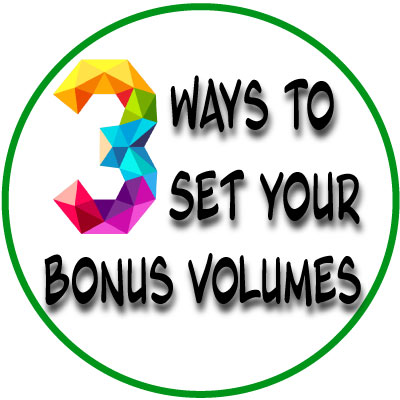 As a multilevel compensation plan designer, I work closely with our clients to help them to make many good decisions. One of these decisions is how to determine the bonus volumes for each of their products or services.
As a multilevel compensation plan designer, I work closely with our clients to help them to make many good decisions. One of these decisions is how to determine the bonus volumes for each of their products or services.
Bonus volume is the basis upon which multilevel compensation is paid. Another term for bonus volume is commissionable volume.
While sometimes clients choose to set the bonus volumes for all of their products or services as a fixed percentage of the retail price, this isn’t always the best decision.
What matters most when you are determining how to set your bonus volumes are the multipliers of each of your products and services.
What Is A Multiplier?
For a direct selling business to be profitable, it must have healthy gross margins.
While margins can be calculated in several ways, we like to use what we call the “multiplier.” The multiplier is a ratio calculated as the suggested retail price of an item divided by the landed cost of the item to the company.
The landed cost is the cost to you to place an item into your fulfillment center (whether it is a warehouse, an office, a basement, a garage, or a spare room), including the costs you will be charged in freight to get it there. Include as well the costs of any additional packaging or refinements you make to an item.
If you purchased 500 bottles of vitamins with a purchase price of $5 per bottle plus $75 for shipping, your landed cost per bottle would be (500 X $5) + $75 = $2575 ÷ 500 = $5.15. Your cost of goods sold (COGS) per bottle would be $5.15.
If the retail price for each bottle of vitamins was $35.00, your multiplier would be $35.00 ÷ $5.15 = 6.80.
The Multiplier: Bonus Volume Relationship
The higher your multiplier, the more you can afford to spend, as a percentage of the price, in total field compensation when that item is purchased.
It is much easier to explain a compensation plan using a set of percentages that don’t vary based upon the multiplier of an item. In your compensation plan, percentages should be uniformly applied to all items sold, while the bonus volume may or may not vary as a percentage of the price.
The higher the multiplier for an item, the higher you can set the bonus volume as a percentage of the price for that item.
Why Your Multiplier Matters
Companies with smaller multipliers pay out a smaller percentage of sales volume in commissions and bonuses. Companies with larger multipliers can afford to have more lucrative compensation plans. Lucrative compensation plans help to attract and retain independent representatives.
Equally important, your multiplier is directly related to your pre-tax profit. The higher your multiplier, the higher your company profit can be.
How To Calculate Your Multiplier
- One average multiplier
- Several average group multipliers
- Unique multipliers
At the start of every compensation plan design or redesign project, we ask our clients to provide us with costing and pricing information so that we can calculate each of these three multipliers. This is one of our proprietary 15 Steps To Compensation Plan Design.
One Average Multiplier
If you choose to set your bonus volumes using one average multiplier, the following will occur:
- The relationship between sales volume and commission basis in your compensation plan will be predictable.
- Bonus volume will equal a fixed percentage of retail price (usually between 50% and 100%).
- Your compensation plan will appear a little simpler as a result.
- Your sales force won’t know which items are less profitable to your company or which items are more profitable.
- They will focus on selling more higher-priced items.
- Your company’s profitability as a percentage of sales will be less certain because your actual average multiplier will not be the same as your estimated average multiplier since your product mix will change over time.
- When your product mix changes, your profitability as a percentage of sales will go up or down.
- You will be less willing to sell a new item whose multiplier is less than your average multiplier because your company profitability as a percentage of sales will drop as a result of introducing the new item.
- You will be more worried about your cost of each new item and so you will negotiate more strongly with your suppliers and sometimes not come to an agreement.
The one average multiplier is a good choice for companies whose range of multipliers across all items is small (for example, 5 to 6).
Several Average Group Multipliers
If you choose to set your bonus volumes using several average multipliers where you group products together with similar multipliers, the following will occur:
- You will have the simplicity of an average multiplier applied to products with similar multipliers.
- Your sales force will know that some groups of items are more profitable for the company than other items.
- Your sales force will try to sell more of your higher multiplier items than the lower multiplier items.
- When you decide to sell a new item, you will need to determine which multiplier group the product will be added to.
- If needed, you will create a brand new multiplier group when the multiplier of the new item is very different from the average multiplier of all existing groups.
- Your compensation plan will be seen as encouraging the sales of higher multiplier group items and discouraging the sales of items of lower multiplier groups.
This several average multipliers approach works best when you can put products into groupings where the average multiplier of each group has a relatively small range (for example, 5 to 6).
Unique Multipliers For Each Item
The third option is to calculate a multiplier for each item. If you choose to set the bonus volume for each item using its own multiplier, the following will occur:
- Your company can introduce lower multiplier items without reducing company profitability.
- If and when your company’s product mix changes, there will be no impact on company profitability as a percentage of sales.
- Your company’s profitability as a percentage of sales won’t change as your product mix changes.
- Your company can introduce new items with multipliers less than the average multiplier with no negative effect on company profitability as a percentage of sales.
- You will have the freedom to worry less about your cost of each item and so you will negotiate less strongly with your suppliers and come to agreements faster and more often.
- For your field, the relationship between sales and the basis for compensation will be variable and unpredictable.
- Your compensation plan will be viewed as more complicated.
- Lower multiplier items will be sold less often by your sales force.
- Your sales force will complain about your multiplier items because they will make less money when these items are purchased.
The unique multipliers approach works well when your range of multipliers is large (4 to 10), you don’t want to use several average multipliers, and you want to be able to sell anything in the future without worrying about the impact on the company’s average multiplier.
An Important Decision
As you can see, there isn’t just one way to set your bonus volumes. There are three ways.
Each approach has its benefits and consequences. Like all other compensation plan design decisions, this one should be made with full consideration of your business model.
If your multiplier for some of your items is very low relative to other items, also read Direct Selling: How To Sell Less Profitable Products.
For confidential assistance with your compensation plan, contact Sylvina Consulting. We are compensation plan experts.

 Jay Leisner, the President of Sylvina Consulting, is a top compensation plan and direct selling expert, a trusted adviser to new and established network marketing and party plan companies. For more than 30 years, Jay has enjoyed assessing and improving network marketing, party plan and referral marketing companies across the globe.
Jay Leisner, the President of Sylvina Consulting, is a top compensation plan and direct selling expert, a trusted adviser to new and established network marketing and party plan companies. For more than 30 years, Jay has enjoyed assessing and improving network marketing, party plan and referral marketing companies across the globe.
Leave a Reply